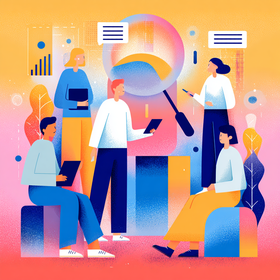D Agile Methodology in UX
Por Redacción Aguayo
Discover how agile methodology transforms user experience design, optimizing processes and outcomes.

Introduction to Agile Methodology in UX
Agile methodology has revolutionized the way digital products are developed and designed, and its application in User Experience (UX) design is no exception. Agile has become a ubiquitous term in the realm of software development and UX design, renowned for its iterative, collaborative, and results-oriented approach.
What is Agile Methodology?
Agile methodology is an iterative and incremental approach to project management and development that emphasizes flexibility, continuous feedback, and rapid delivery of value. It emerged as a response to traditional project management methods, which were often rigid and less adaptable to changes in user requirements and needs.
In contrast to traditional approaches, Agile promotes close collaboration among multidisciplinary teams, self-organization, and continuous adaptation as the project unfolds. It is designed to manage the inherent complexity of software development and UX design projects, offering a structured way to respond to rapid changes in client and market requirements.
Fundamental Principles of Agile Methodology
The fundamental principles of Agile methodology are outlined in the Agile Manifesto, which establishes the values and principles guiding Agile practices. Some of these principles include:
- Individuals and interactions over processes and tools: Agile prioritizes direct communication and collaboration among team members over strict adherence to processes and tools.
- Working software over comprehensive documentation: Delivery of functional and usable software is valued more than extensive documentation.
- Customer collaboration over contract negotiation: It encourages ongoing collaboration with the customer to understand and meet their needs, rather than focusing solely on formalizing contractual agreements.
- Responding to change over following a plan: Agile acknowledges the inevitability of change in requirements and prioritizes the ability to respond to these changes flexibly and swiftly.
Applying Agile Methodology in UX
In the context of UX, Agile methodology particularly adapts well due to its focus on continuous delivery of value and early user feedback. It allows UX design teams to work in short development cycles, known as iterations or sprints, where each cycle produces a set of features or improvements that can be evaluated by users.
Integrating UX into Agile teams involves close collaboration among designers, developers, and other stakeholders from the project's outset. Agile principles encourage active involvement of end-users throughout the design process, ensuring that proposed solutions truly meet user needs and enhance their overall experience with the product.
Benefits of Implementing Agile Methodology in UX
Implementing Agile methodology in UX design offers several significant benefits:
- Greater adaptability: Enables teams to respond quickly to changes in user preferences and expectations, as well as new market opportunities.
- Continuous delivery of value: Users experience gradual and steady improvements in usability and functionality throughout the development cycle.
- Risk reduction: Early and frequent user feedback helps identify and mitigate potential risks before they escalate.
- Enhanced collaboration: Fosters a culture of collaboration and transparency among teams, facilitating rapid problem-solving and informed decision-making.
In summary, Agile methodology has not only transformed how digital products are developed but has also raised the standard of what users expect in terms of experience. By integrating Agile principles into UX design, organizations can not only create more effective and satisfying products but also establish a solid foundation for continuous innovation and long-term success.
Principles and Agile Values in User Experience Design
The application of Agile principles and values in User Experience (UX) design is essential for creating digital products that are not only functional but also highly satisfying and adaptive to user needs. These principles not only transform how design teams work but also enhance the quality of experiences they deliver to end users.
Fundamentals of Agile Principles
Agile principles are based on the Agile Manifesto, a document that establishes core values and guiding principles for agile software development. These principles include:
- Individuals and interactions over processes and tools: Agile emphasizes the importance of interpersonal relationships and direct collaboration within the team. This is crucial in UX design, where effective communication among designers, developers, and stakeholders is essential to understand and address user needs.
- Working software over comprehensive documentation: In Agile UX design, the goal is to create effective and functional user experiences. This means prioritizing the delivery of products that users can directly use and experience over detailed and extensive documentation that can often slow down the design process.
- Customer collaboration over contract negotiation: Agile methodology encourages continuous collaboration with clients and end users throughout the design process. This allows for early and frequent feedback, which is critical for iteratively adjusting and improving UX design based on real user needs and expectations.
- Responding to change over following a plan: Adaptability is a fundamental principle of Agile UX design. As user requirements evolve and change, agile teams are prepared to adjust their approaches and design priorities flexibly and efficiently, ensuring that the final product effectively meets market demands.
Core Values of the Agile Manifesto
The Agile Manifesto establishes four core values that guide the implementation of Agile methodology in any context, including UX design:
- Individuals and interactions over processes and tools
- Working software over comprehensive documentation
- Customer collaboration over contract negotiation
- Responding to change over following a plan
These values provide a clear framework for prioritizing effective communication, continuous delivery of user value, and the ability to adapt quickly to changes in the market environment and user needs.
Practical Application in User Experience Design
In UX design, the application of Agile principles translates into the creation of iterative and collaborative development cycles. Design teams work in sprints or short iterations, delivering prototypes and incremental functionalities that can be continuously evaluated and validated by users.
Integrating Agile methodology into UX design not only enhances the speed and efficiency of the design process but also ensures that the final product is optimally aligned with changing user expectations and needs. The flexibility and adaptability inherent in Agile principles allow UX teams to innovate and constantly evolve their designs to deliver exceptional and competitive user experiences in today's digital market.
Roles and Responsibilities in Agile UX Teams
In Agile User Experience (UX) teams, each member plays specific roles and responsibilities that contribute to the project's success and the achievement of design objectives. These roles are designed to foster collaboration, maximize efficiency, and ensure that the final product effectively meets user needs and expectations.
Key Roles in Agile UX Teams
- Product Owner: The Product Owner is responsible for representing customer and user interests within the agile team. Their primary role is to define product functionalities, prioritize the backlog, and make decisions that maximize product value for end-users.
- Scrum Master: The Scrum Master acts as a facilitator and team leader in the agile environment. Their role is to ensure the team understands and adopts agile principles and practices, remove obstacles that may hinder productivity, and facilitate agile ceremonies such as daily stand-ups, sprint planning, and retrospectives.
- Development Team: The development team consists of multidisciplinary professionals, including UX/UI designers, software developers, testers, analysts, and other specialized roles necessary for product delivery. Their primary responsibility is to collaborate to complete backlog tasks during each sprint.
Collaboration and Shared Responsibilities
In an Agile UX team, effective collaboration among roles is crucial for project success. Some shared responsibilities include:
- Collaboration in requirement definition: Both the Product Owner and UX designers collaborate closely to understand and prioritize user and business requirements.
- Continuous iteration: UX designers work closely with developers to iterate on designs and prototypes in each sprint cycle, ensuring proposed solutions are technically feasible and satisfactory from a user experience standpoint.
- Testing and validation: Testers and analysts collaborate with UX designers to conduct usability testing and verify product quality before release, ensuring it meets quality standards and end-user expectations.
Flexibility and Adaptability
A key principle of Agile UX teams is their ability to adapt quickly to user feedback and changes. Roles in these teams are designed to be flexible and adaptable, allowing continuous adjustments based on emerging project and market needs.
Benefits of Agile Role Structure in UX
The Agile role structure in UX offers several significant benefits:
- Greater alignment with end-users: Roles are oriented to ensure the final product meets user needs and expectations, consistently aligned with backlog priorities and client feedback.
- Efficiency and productivity: Clear responsibilities and effective role collaboration promote team efficiency and productivity, optimizing time and resources allocated to each project phase.
- Risk reduction: Clear role distribution enables effective risk management, with constant attention to product quality and usability in each development iteration.
In conclusion, roles and responsibilities in Agile UX teams are designed to maximize efficiency, collaboration, and the quality of the final product, ensuring every aspect of design and development aligns with user needs and expectations in an agile and dynamic environment.
Iterative Processes and Deliverables in Agile Methodology
Agile methodology is characterized by its iterative and incremental approach to product development, which is fundamental to User Experience (UX) design. This chapter explores how iterative processes and deliverables are integrated into Agile methodology, ensuring continuous delivery of value and agile adaptation to evolving user and market needs.
Iterative Development Cycles
In Agile methodology, UX teams work in development cycles called "sprints." Each sprint has a defined duration (typically one to four weeks) and focuses on delivering a specific set of functionalities or product improvements. During each sprint, the team follows a series of iterative steps:
- Sprint Planning: The development team, along with the Product Owner and Scrum Master, plans the tasks to be addressed during the sprint. Product backlog items are prioritized based on their value and complexity.
- UX Design and Development: UX designers collaborate closely with developers to create prototypes and functional designs that address user needs and expectations. They focus on creating iterative solutions that can be continuously validated and improved.
- Testing and Feedback: As sprint functionalities are completed, the team conducts usability and quality tests to verify that the product meets established standards and user expectations. User feedback is collected and reviewed with the Product Owner to ensure that implemented functionalities are effective and satisfactory.
- Review and Continuous Improvement: At the end of each sprint, the team conducts a retrospective review to assess what worked well and what areas need improvement. This feedback is used to adjust and enhance processes and deliverables in upcoming sprints, promoting continuous improvement in UX design quality and efficiency.
Deliverables in Agile Methodology
Deliverables in Agile methodology are iterative and focus on providing tangible value at each stage of the development process. Some of the key deliverables include:
- Iterative Prototypes: Functional and evolutionary versions of user interfaces that allow for validation of concepts and early user feedback.
- User Stories: Detailed descriptions of features and functionalities from the end-user perspective, used to prioritize and guide development in each sprint.
- Minimal Necessary Documentation: Focus on creating fair and necessary documentation to maintain transparency and facilitate collaboration, without falling into excess that can slow down the process.
Adaptability and Flexibility
One of the key benefits of iterative processes in Agile methodology is their ability to quickly adapt to changes and new market opportunities. UX teams can adjust priorities and functionalities based on user feedback and business demands, ensuring the final product remains relevant and competitive in a dynamic market.
Benefits of Iterative Processes in UX
Adopting iterative processes in Agile methodology offers several significant benefits:
- Increased user involvement: Continuous delivery of functionalities allows users to provide early feedback, thereby improving product alignment with their needs and expectations.
- Risk reduction: The ability to iteratively test and validate reduces risks associated with product development, ensuring that issues are identified and addressed early on.
- Continuous improvement: Frequent feedback and retrospective review promote continuous improvement in product quality and UX team efficiency.
Tools and Technologies for Agile Implementation in UX
In Agile methodology applied to User Experience (UX), the use of appropriate tools and technologies plays a crucial role in optimizing team collaboration, communication, and efficiency. This chapter explores some of the most common tools and technologies used to facilitate Agile implementation in UX projects, thereby enhancing the quality of the final product and user satisfaction.
Agile Project Management Tools
- Jira: Jira is an Agile project management tool that allows teams to efficiently plan, track, and manage software development progress. It is widely used for creating and tracking user stories, sprint management, and conducting retrospectives, facilitating transparent and collaborative project management.
- Trello: Trello is a visual management tool that uses boards, lists, and cards to organize tasks and projects intuitively. It is ideal for Agile UX teams preferring a visual interface to manage and prioritize tasks, assign responsibilities, and track progress in real-time.
- Asana: Asana is a versatile tool that combines task management, calendars, and communication in one place. It facilitates collaboration across teams by enabling clear assignment of responsibilities, milestone scheduling, and effective communication, all of which are essential for Agile implementation in UX projects.
Collaboration and UX Design Tools
- Figma: Figma is a cloud-based collaborative design tool that allows teams to create, collaborate, and prototype user interfaces effectively. Its real-time collaboration capabilities and integration with prototyping tools make Figma a popular choice among Agile UX teams for rapid creation and validation of iterative designs.
- Adobe XD: Adobe XD is another leading tool for designing and prototyping user interfaces, facilitating the creation of interactive experiences. With collaboration features and the ability to create high-fidelity interactive prototypes, Adobe XD is ideal for teams looking to seamlessly integrate design and development in an Agile environment.
- Sketch: Sketch is a vector design tool primarily used by UX/UI designers to create modern, responsive user interfaces. Initially focused on macOS, its popularity has grown due to its plugin integration capabilities that facilitate collaborative work and iterative prototyping.
Technologies for UX Testing and Validation
- UserTesting: UserTesting is a platform that allows teams to conduct usability testing and gather feedback from real users quickly and effectively. It facilitates capturing user sessions on video and collecting qualitative feedback, essential for validating design hypotheses and continuously improving user experience.
- Hotjar: Hotjar offers visual feedback and analysis tools that help teams understand user behavior on websites and applications. With heatmaps, user session recordings, and instant surveys, Hotjar helps identify friction points and improvement opportunities in UX, optimizing user experience with each development iteration.
Integrating Tools and Technologies in Agile Methodologies
Effectively integrating these tools and technologies in Agile methodologies not only improves team collaboration and efficiency but also enables rapid and continuous iteration in UX design and development. By strategically using these tools, teams can better adapt to market changes and user needs, ensuring the delivery of high-quality products that meet the expectations of end users.
Multidisciplinary Collaboration in Agile UX Teams
Agile methodology in User Experience (UX) design promotes multidisciplinary collaboration as one of its fundamental pillars. This chapter explores how collaboration among different disciplines in Agile UX teams contributes to creating user-centered products, enhancing design quality, and customer satisfaction.
Importance of Multidisciplinary Collaboration
In Agile UX teams, multidisciplinary collaboration brings together professionals with diverse skills and perspectives, including UX/UI designers, developers, business analysts, usability experts, and more. This diversity allows teams to address issues from multiple angles and ensures that all aspects of product design and development are considered.
Roles and Responsibilities
Each member of the Agile UX team brings specific skills that complement the design and development process. Some common roles include:
- UX/UI Designer: Responsible for creating intuitive and appealing user interfaces that meet the needs of end-users.
- Developer: In charge of implementing the designed solutions, ensuring functionality and usability are maintained during development.
- Business Analyst: Helps translate business requirements into technical functionalities and ensures the final product meets business goals.
- Usability Specialist: Conducts usability testing and gathers user feedback to validate and continuously improve product design.
Collaboration Process
Multidisciplinary collaboration in Agile UX teams is facilitated through specific practices and tools:
- Daily Standups: Short, regular sessions where the team shares quick updates on progress, obstacles, and daily goals.
- Collaborative Design: Use of real-time design tools that allow different team members to work simultaneously on the same project, promoting co-creation and integration of diverse perspectives.
- Iterative Prototyping: Rapid prototyping and frequent user testing to iterate and continuously improve design based on immediate feedback.
Benefits of Multidisciplinary Collaboration
Effective collaboration across disciplines in Agile UX teams provides several key benefits:
- Improved Product Quality: The combination of diverse skills ensures the final product is functional, aesthetically pleasing, and aligned with user and business objectives.
- Quick Problem Resolution: Diverse perspectives enable comprehensive problem-solving and faster innovation in finding solutions.
- Higher Team Satisfaction: Multidisciplinary collaboration fosters a collaborative and enriching work environment where team members feel valued and motivated.
Challenges and Considerations
Despite its advantages, multidisciplinary collaboration also presents challenges, such as communication differences, discrepancies in priorities, and the need to effectively manage expectations and roles of each team member.
Benefits of Agile Methodology in Digital Product Development
Agile methodology has significantly transformed the way digital products are developed, offering a range of benefits that promote efficiency, flexibility, and customer satisfaction. This chapter explores how adopting agile practices in digital product development can benefit both development teams and end-users.
Adaptability and Flexibility
One of the key benefits of agile methodology is its ability to quickly adapt to changes in customer or market requirements. Through iterative development cycles and frequent deliveries, teams can continuously adjust and improve the product in response to feedback and emerging needs.
Incremental Deliveries
Agile encourages incremental delivery of functionalities, allowing teams to develop and deploy parts of the product gradually and in stages. This not only facilitates better risk management and faster delivery times but also enables users to start benefiting from the product earlier in the development process.
Focus on Quality
Through practices such as continuous testing and continuous integration, agile methodology prioritizes product quality from the early stages of development. By identifying and addressing quality issues early and frequently, teams can reduce errors and enhance the stability and usability of the final product.
Active Collaboration and Transparency
Agile principles foster a culture of active collaboration and transparency within the team and with stakeholders. Daily stand-ups and regular retrospectives promote open communication, idea exchange, and joint problem-solving, strengthening team engagement and improving alignment with project goals.
Continuous Improvement and Rapid Feedback
Continuous feedback from users and stakeholders throughout the development process allows teams to iteratively adjust and improve the product. This rapid responsiveness to feedback ensures that the final product not only meets user expectations but also adapts to changes in the market and customer needs.
Cost Reduction and Development Time
By minimizing waste and focusing on delivering incremental value, agile methodology can help reduce overall costs and accelerate development times. The ability to identify and correct issues in a timely manner also helps avoid additional costs associated with last-minute changes or product failures.
Alignment with Business Objectives
Finally, agile methodology ensures better alignment with business goals and strategies by enabling flexible planning and adaptive execution. Teams can prioritize features and functionalities that add the most business value, thereby maximizing return on investment (ROI) and customer satisfaction.
In conclusion, agile methodology not only enhances efficiency and quality in digital product development but also promotes a culture of innovation, collaboration, and continuous improvement. By adopting agile practices, organizations can effectively respond to market challenges and deliver products that not only meet but exceed user and stakeholder expectations.
Successful Integration of Agile Methodologies in UX
The integration of agile methodologies in User Experience (UX) design represents a significant advancement towards creating user-centered, adaptive, and high-quality digital products. Throughout this text, we have explored the foundations, practices, and key benefits that agile methodologies bring to the UX development process, as well as the challenges and important considerations to keep in mind.
Recap of Benefits
During our exploration, we have seen how agile methodologies promote:
- Flexibility and Adaptability: Allowing quick adjustments to changes in requirements and user needs.
- Incremental Deliveries: Facilitating early delivery of value and continuous validation with users.
- Focus on Quality: Through continuous testing and constant feedback to enhance usability and functionality of the product.
- Collaboration and Transparency: Fostering a collaborative environment where all disciplines bring their unique perspectives.
- Continuous Improvement: Integrating feedback to iterate and enhance design in each development cycle.
Challenges and Considerations
However, we have also identified potential challenges, such as managing cultural change within organizations, the need for clear and effective communication, and the ability to maintain agile discipline in diverse and dynamic environments.
Future of Agile Methodologies in UX
Looking ahead, agile methodologies in UX are evolving to address new challenges and opportunities in an increasingly complex digital world. The integration of artificial intelligence, advanced data analytics, and agile methodologies is expected to continue driving innovation and enhancing user experience.
Ethical Considerations and Responsibility
It is crucial to maintain an ethical focus in agile design, ensuring that decisions made not only optimize user experience but also respect privacy, fairness, and data security.
Importance of User Feedback
Finally, continuous user feedback remains crucial to the success of any agile UX project. Listening to and understanding user needs and expectations allows teams to design products that truly add value and improve people's lives.
Final Conclusion
In summary, adopting agile methodologies in UX not only improves efficiency and quality in digital product development but also drives innovation, strengthens interdisciplinary collaboration, and ensures greater user satisfaction. By tackling challenges with determination and seizing emerging opportunities, organizations can position their products as market leaders, delivering exceptional experiences that captivate and retain users.






























































































































































































































